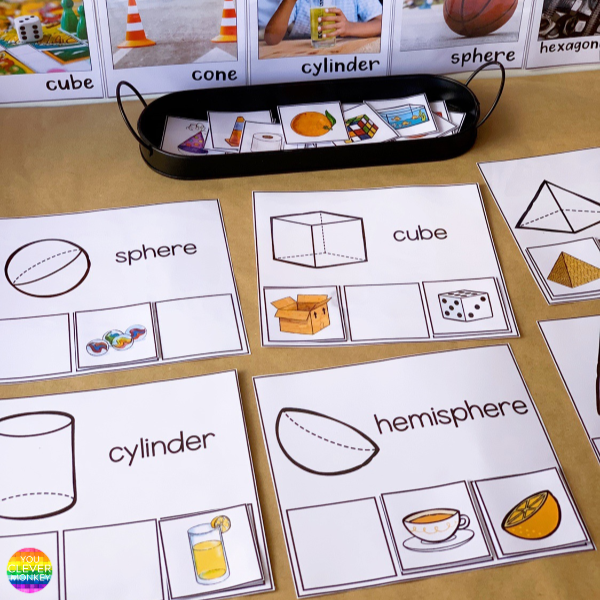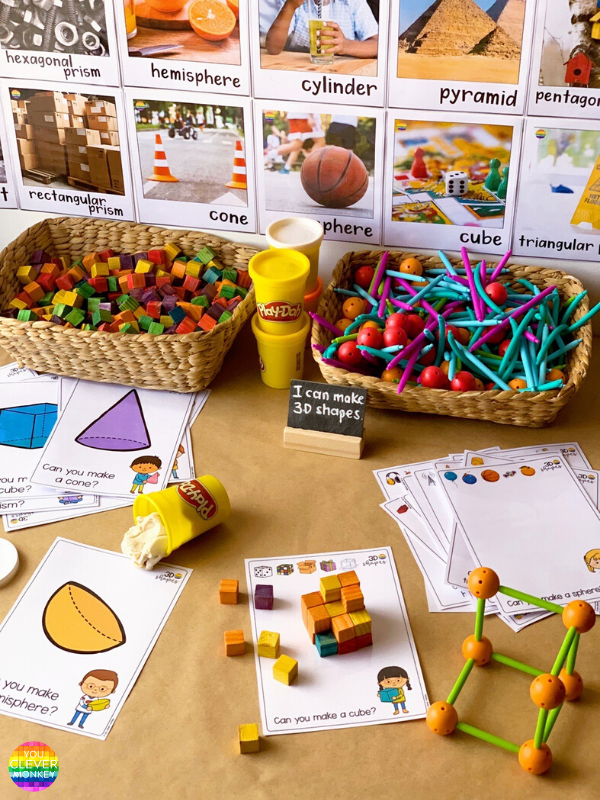Hands-on ideas and printables for teaching young children 3D shapes.
Years ago I wrote about the most effective ways to teach shapes and build spatial awareness in the Early Years at school.
Much of what I wrote then is still true today in schools. Young children need repeated hands-on play with different 3D objects to understand them and they need clear, accurate information from their teachers to avoid the confusion between surface or two dimensional shapes and three-dimensional shapes that exists in many young children.
This post contains affiliate links.
The book Blocks and Beyond - Strengthening Early Math and Science Skills Through Spatial Learning is a valuable resource for any teacher working in Early Childhood.
It provides many ideas for activities that can help support a young child's growing understanding of shape.
At the start of teaching 3D objects, we always go through the different language used to describe 3D objects vs 2D shape. Edges vs sides, corners vs vertices. We introduce our word wall cards and shape posters at the same time.
This simple paper foldable from Hooty's Homeroom is a good hands-on finish to your first lesson. From a single piece of paper, children can may a basic 3D object which can be labelled with the correct terms.
This simple paper foldable from Hooty's Homeroom is a good hands-on finish to your first lesson. From a single piece of paper, children can may a basic 3D object which can be labelled with the correct terms.
The Australian Curriculum tells us students in their first year at school should be able to 'sort, describe and name familiar two-dimensional shapes and three-dimensional objects in the environment.'
By comparison, Year 1 students should be able to 'recognise and classify familiar two-dimensional shapes and three-dimensional objects using obvious features' and Year 2 students should be able to 'describe and draw two-dimensional shapes, with and without digital technologies and describe the features of three-dimensional objects'.
All of which is not dissimilar to the US Common Core standards for Kindergarten and beyond.
All of which is not dissimilar to the US Common Core standards for Kindergarten and beyond.
YOU MIGHT ALSO LIKE
HANDS-ON IDEAS FOR TEACHING 3D OBJECTS
Children love to put what they know into action and as Early Years teachers, we know that's how they learn best.
Here are some of our favourite ways to learn about 3D objects -
1. Place different 3D objects into a bag or sensory tub and have your children describe them by feel.
Encourage the use of correct terms like face, edge, vertices, curved and flat surfaces
2. Experiment to see how the different objects move. Work in small groups or pairs to build some simple ramps and move the objects down the ramp before sorting them.
You will find this template included in our 3D Object Activities Pack. Click here for more details.
3. Go on a 3D shape hunt in the environment. Real world examples can help children understand some math concepts more easily. Can't get outside easily? Try these spin and cover games that use real life images to match.
Or use this Draw The Room activity instead. It has some tasks that just ask children to recognise and match the shape but also allows an option to try and draw the shape found. You can find it here.
Comparing and sorting images of real life 3D objects is another way to do this if working outside your classroom isn't possible.
4. Or use these puzzle cards for sorting or turn them into a game of memory either matching two cards - name and shape or three cards at a time to make the game more challenging.
5. These geometric shapes building set from Learning Resources are so engaging and are a perfect way to explore shape. My children LOVE these! You can find them here.
You can find our 3D and 2D shape Word Wall cards here.
6. Use these printable mats in a lesson to intentionally teach the different properties of 3D shape or add them to your play dough table as a math centre invitation.
Few children can resist the appeal of play dough. To introduce the use of these mats, I do this as a whole class and display different 3D objects on the board for the children to try and make with just playdough firstly.
You can grab these 3D playdough mats from HERE.
Or use the same mats and use playdough + toothpicks or plasticine or frozen peas work in place of playdough. For older children, small pieces of pipe cleaners and straws allow them to build larger, sturdier 3D objects.
7. Build the different shapes from Magnatiles. These blocks are guaranteed to engage young children and they are perfect for making 3D objects.
8. Play games to help build familiarity with the different shapes. BINGO and Connect 4 are perfect for independent math centres.
9. Use paper nets to create different 3D objects. Better for older children who have learnt to fold more precisely. You can find some ready to print nets in our 3D Object Activities Pack.
10. Add some 3D objects to your kinetic sand and invite your students to play. You can find the 3D objects we used here. By stamping the shape into the sand, children can see what 2D shape the different faces might be too.
11. Sort a collection of 2D and 3D shapes into two groups.
This geometric shape set from Learning Resources can be used together with this 3D object set to sort. Children will then relate flat shapes as being 2D while objects are 3D. A handy resource for working on fractions too.
Alternatively you could used a printable like these 3D shape sorting mats to create a similar invitation.
These mats also help children link the abstract to concrete real life examples.
12. Trace around the base of some 3D objects to discover their 2D face shape. Or stamp them into kinetic sand.
This activity is always a crowd pleaser in class and perfect for build spatial awareness in young children.
13. Play a game of 'Guess Who?' with shapes. The children can only ask yes/no questions of each other to work out the shape.
14. Provide open ended materials to prompt exploration of the different shapes.
Here our simple shape mats were left with a few different materials and the children then were left to decide what to use.
Their explanations of why they choose playdough to make the sphere and blocks to make the cube is were you get to see their understanding in action.
Here our simple shape mats were left with a few different materials and the children then were left to decide what to use.
Their explanations of why they choose playdough to make the sphere and blocks to make the cube is were you get to see their understanding in action.
15. Create some sculptures from recycled materials then count how many different 3D shapes have been used.
Providing a print rich environment for children to learn the terms specific to maths also helps young children master the language needed to describe and label the different shapes.













